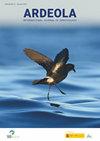v - net与回放:一个积极的经济有效的方法捕获小轨道
IF 1.2
4区 生物学
Q2 ORNITHOLOGY
引用次数: 4
摘要
由于它们的秘密习性和缺乏适当的研究方法,小轨道仍然鲜为人知。在这里,我们描述并测试了一种捕获小轨道的新方法。V型网的布置包括两个12米的雾网,放置在地面上,沿着先前清理的小径形成一个V型。雾网的底部放置在地面上,面向V向内,并用木桩固定,以防止鸟类逃跑。鸟类通过回放技术被引诱到V型云网中,并由两名监控鸟类反应并做出相应反应的人员驱赶到雾网中。我们在新热带地区对6种侧边秧进行了试验,共20次捕获20只,其中灰胸秧3只、黑带秧3只、红白秧5只、黑边秧3只、红边秧4只、黄面秧2只。虽然变化很大,但平均捕获成功导致每次设置捕获一次。我们在高而密集的栖息地捕获小轨道的方法提供了一种新的、有效的、安全的替代方案,它是集中的、积极监测的和动态的。它可以有效地用来诱捕其他居住在茂密和高大栖息地的陆地鸟类。——E.A.德皮诺和J.I.阿雷塔(2020)。带回放的v网:捕获小轨道的一种有效的经济有效的方法。本文章由计算机程序翻译,如有差异,请以英文原文为准。
V-Netting with Playback: an Active Cost-Effective Method for Trapping Small Rails
Small rails remain poorly known due to their secretive habits and the lack of adequate methods for their study. Here we describe and test a novel method for trapping small rails. The V-netting arrangement comprises two 12m mist-nets placed at ground level, forming a V along previously cleared trails. The bottom of the mist-net is positioned on the ground facing the V inwards and staked to prevent birds from escaping. Birds are lured inside the V using playback and driven into the mist-nets by two people that monitor bird responses and react accordingly. We tested this method across the Neotropical region with six species of Laterallus crakes, capturing 20 individuals in 20 attempts, comprising three Grey-breasted Crakes L. exilis, three Black-banded Crakes L. fasciatus (= Porzana fasciata), five Red-and-white Crakes L. leucopyrrhus, three Rufous-sided Crakes L. melanophaius, four Ruddy Crakes L. ruber and two Rufous-faced Crakes L. xenopterus. Although variation was large, mean capture success resulted in one capture per setup. Our method for capturing small rails in tall and dense habitats provides a new, efficient and safe alternative that is focused, actively monitored and dynamic. It may be profitably used to trap other territorial land birds of dense and tall habitats.—Depino, E.A. & Areta, J.I. (2020). V-netting with playback: an active cost-effective method for trapping small rails.
求助全文
通过发布文献求助,成功后即可免费获取论文全文。
去求助
来源期刊
CiteScore
2.30
自引率
6.20%
发文量
16
审稿时长
>12 weeks
期刊介绍:
Ardeola: International Journal of Ornithology is the scientific journal of SEO/BirdLife, the Spanish Ornithological Society. The journal had a regional focus when it was first published, in 1954. Since then, and particular during the past two decades, the journal has expanded its thematic and geographical scope. It is now a fully international forum for research on all aspects of ornithology. We thus welcome studies within the fields of basic biology, ecology, behaviour, conservation and biogeography, especially those arising from hypothesis-based research. Although we have a long publication history of Mediterranean and Neotropical studies, we accept papers on investigations worldwide.
Each volume of Ardeola has two parts, published annually in January and July. The main body of each issue comprises full-length original articles (Papersand Review articles) and shorter notes on methodology or stimulating findings (Short Communications). The publication language is English, with summaries, figure legends and table captions also in Spanish. Ardeolaalso publishes critical Book Reviewsand PhD-Dissertation Summaries; summarising ornithological theses defended in Spain. Finally there are two Spanish-language sections, Ornithological News; summarising significant recent observations of birds in Spain, and Observations of Rare Birds in Spain, the annual reports of the Spanish Rarities Committee.

 求助内容:
求助内容: 应助结果提醒方式:
应助结果提醒方式:


